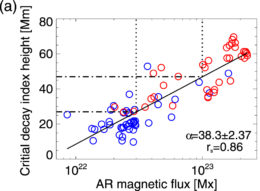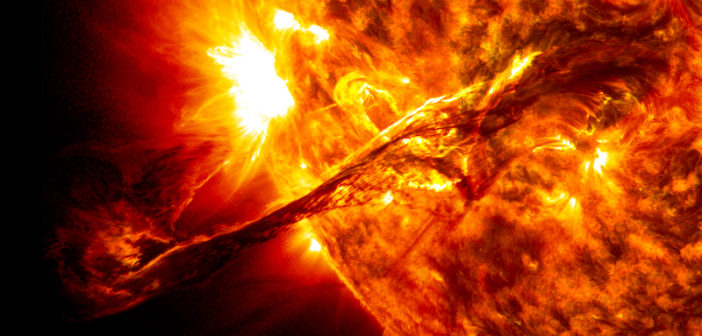Can we tell when a solar flare will lead to a potentially hazardous eruption of plasma from the Sun? A new look at hundreds of past solar flares may provide some clues.
Belches from the Sun

A large solar flare may or may not be accompanied by a violent ejection of matter in a CME. [NASA/SDO]
The Earth’s magnetic field does a good job of protecting us from the greatest impact of these eruptions, but a CME directed at Earth still has the potential to be hazardous to our technology and communications systems, as well as to any unshielded life (such as astronauts on a lunar mission). Scientists are therefore interested in better understanding which solar flares are likely to be eruptive — i.e., accompanied by a CME — and which ones will instead be confined.

Top: For active regions with low magnetic flux, more flares tend to be eruptive (blue), whereas for active regions with high magnetic flux, more flares tend to be confined (red). Bottom: The proportion of eruptive flares (PE) decreases with increasing active region magnetic flux. [Adapted from Li et al. 2020]
A Decade of Activity
To this end, a team of scientists led by Ting Li (Chinese Academy of Sciences) recently constructed an extensive catalog of large (M- and X-class) solar flares and associated CMEs observed in 2010–2019 — a time period that spans nearly the entirety of the Sun’s most recent solar activity cycle.
The team then analyzed the 322 resulting flares and cataloged them as either eruptive or confined, depending on whether or not there was an associated CME. Finally, Li and collaborators analyzed the properties of the active regions from which the flares and CMEs arose.
Exercising Magnetic Restraint
Li and collaborators found an anticorrelation between the total magnetic flux of active regions and the proportion of eruptive flares. That means that the active regions with especially small magnetic fluxes were very likely to have flares with accompanying CMEs, whereas the active regions with especially large magnetic fluxes were more likely to have confined flares with no eruptions.

The critical decay index height vs. active region magnetic flux for eruptive (blue) and confined (red) flares shows that regions with more magnetic flux are also more confined. [Adapted from Li et al. 2020]
Space Weather Predictions
Li and collaborators’ publicly available catalog and results provide us with valuable clues to help forecast CMEs in association with large flares. In addition, these outcomes could have implications beyond our own solar system: they may help us to better understand the flares we’ve witnessed from other stars and even assess the potential habitability of their planets. As we learn more, future solar and stellar belches may become just a little less unpredictable.
Citation
“Magnetic Flux of Active Regions Determining the Eruptive Character of Large Solar Flares,” Ting Li et al 2020 ApJ 900 128. doi:10.3847/1538-4357/aba6ef
